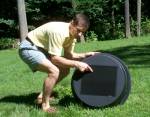Search engine visitors - click here to access entire "$ensible Home" web site
Click here to see a descriptive illustration of several types of solar-powered attic vent fans.
Dear Jim: Our house feels warm even with the air conditioner running. The temperature seems to be low enough for comfort. Could the heat be coming from the attic? Will solar-powered attic fans help much? - Caroline J.

A: Your situation is not uncommon. My guess is, if you put your hand on the ceiling, it will feel warm. Even though the room air is cool, you feel warm from radiant heat transfer. It is the reverse of when you feel chilly during winter when you sit near an outside wall or window.
In addition to your feeling warm, your central air conditioner is running overtime to remove this excess radiant heat coming down through the ceiling from a hot attic. To make matters worse, you often have to set the thermostat lower to stay comfortable and your electric bills go even higher.
A solar-powered attic exhaust fan is a good choice to help keep your attic and roof, and thus the ceiling below, cooler. A solar-powered fan is an ideal match for your needs because as the sun is more intense on the roof, it also creates more free solar electricity so the fan runs faster.
Another monetary benefit of keeping your attic and roof cooler is the life of the shingles will be extended. High heat hastens the degradation of just about any material used in a house. By locating one or two solar fans up near the peak of the roof, the hottest air will be drawn out of the attic.
You don't have to be an electrician to install a solar attic fan. The solar panel is built into the top of the fan and it produces free electricity. To install one, you just have to saw a 12-inch-diameter hole in the roof and loosen a few shingles. Nail the fan in place and replace the shingles. Curb-mounted models are also available for flat and tile roofs.
If the area of your roof where you want to install the fan does not face the sun directly, you can install a remote fan. It uses a similar fan, but it has a separate solar panel. The one-foot-square solar panel, on an adjustable stand, can be mounted up to 20 feet away in a sunny location.
The remote panel may be the most efficient option because the small solar panel stays cooler than when it is built into the top of the fan. The hotter solar cells get, the less free electricity they produce. The small wire, that carries the safe 12 volts, can barely be seen on the roof. You may also consider attaching two solar panels to one fan for extra cooling.
Another installation option to consider is a built-in design with a hinged solar panel. It can be tilted up from the fan top to face the sun more directly. Also, with the solar panel tilted upward, even at a slight angle, air flows around it to keep it cooler and keep its efficiency high.
Instant Download Update Bulletin No. 987 - buyer's guide of 11 solar-powered attic vent fan and turbine fan manufacturers listing air flow ratings, watts, sizes, features, prices, sizing chart for number of fans required per square foot of attic, installation methods with illustrations, and descriptions/illustrations of various models.
Dear Jim: I saw a show on television which showed an air conditioner which used no freon, just water, and used little electricity. Can this type of cooling system be installed in any home? - Sandy B.
A: It sounds like you are describing a swamp cooler. It works by evaporating water into a stream of air. As the water evaporates, it cools the air similarly to how perspiration cools your skin.
Swamp coolers are effective only in dry climates. If you would use one in a hot humid climate, there would be less cooling effect because the air is already nearly saturated with water vapor. It would also make the indoor air even more muggy.